قائمة أباطرة أسرة مينگ
(تم التحويل من List of emperors of the Ming dynasty)
أسرة مينگ حكمت الصين من 1368 إلى 1644، لتخلِف أسرة يوان التي كان يقودها منغول وسقطت وسط الكثير من اضطرابات الفلاحين لتخلفها أسرة تشينگ التي كان يقودها المانچو. ستة عشر امبراطوراً حكموا كل الصين لمدة 276 سنة. سلسلة من المطالبين بعرش مينگ واصلوا المطالبة، في ما سُمِّيَ مينگ الجنوبية حتى أُعدِم آخرهم في 1662.
حسب قواعد البيت الامبراطوري، الحرف الأول من أسماء أمراء مينگ هو اسم الجيل، بينما الحرف الثاني يضم حرف جذري يدور في العناصر الخمس للفلسفة الصينية، وهم، 木 (الخشب) 火 (النار) 土 (الأرض) 金 (المعدن) 水 (الماء)، بدءاً من الجيل التالي للمؤسس الإمبراطوري ژو يوانژانگ.
أباطرة أسرة مينگ
| الاسم الأكثر شيوعاً | پورتريه | سنوات الحكم | الاسم المعطى | اسم العهد | الاسم بعد الموت1 (صيغة قصيرة) | اسم المعبد1 |
|---|---|---|---|---|---|---|
| هونگوو الامبراطور Vastly Martial |

|
1368–1398 |
Zhū Yuánzhāng 朱元璋 |
Hóngwǔ 洪武 |
Gāodì 高帝 |
Tàizǔ 太祖 |
| Jianwen Emperor Establishing Civility |
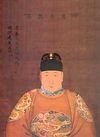
|
1398–1402 | Zhū Yǔnwén 朱允炆 |
Jiànwén 建文 |
Rangdì 讓帝 |
Huizong 惠宗 |
| Yongle Emperor Perpetual Happiness |

|
1402–1424 | Zhū Dì 朱棣 |
Yǒnglè 永樂 |
Wéndì 文帝 |
Tàizōng 太宗 and Chéngzǔ 成祖2 |
| Hongxi Emperor Vastly Bright |
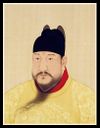
|
1424–1425 | Zhū Gāochì 朱高熾 |
Hóngxī 洪熙 |
Zhāodì 昭帝 |
Rénzōng 仁宗 |
| Xuande Emperor Proclamation of Virtue |

|
1425–1435 | Zhū Zhānjī 朱瞻基 |
Xuāndé 宣德 |
Zhāngdì 章帝 |
Xuānzōng 宣宗 |
| Emperor Yingzong of Ming | 
|
1435–14493 and 1457–1464 |
Zhū Qízhèn 朱祁鎮 |
Zhèngtǒng 正統 and Tiānshùn 天順 |
Ruìdì 睿帝 |
Yīngzōng 英宗 |
| Jingtai Emperor Exalted View |

|
1449–1457 | Zhū Qíyù 朱祁鈺 |
Jǐngtài 景泰 |
Jǐngdì 景帝 |
Dàizōng 代宗 |
| Chenghua Emperor Accomplished Change |
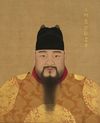
|
1464–1487 | Zhū Jiànshēn 朱見深 |
Chénghuà 成化 |
Chúndì 純帝 |
Xiànzōng 憲宗 |
| Hongzhi Emperor حكم عظيم |

|
1487–1505 | Zhū Yòuchēng 朱祐樘 |
Hóngzhì 弘治 |
Jìngdì 敬帝 |
Xiàozōng 孝宗 |
| ژنگدى الامبراطور تقويم الفضيلة |
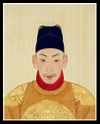
|
1505–1521 | Zhū Hòuzhào 朱厚㷖 |
Zhèngdé 正德 |
Yìdì 毅帝 |
Wǔzōng 武宗 |
| Jiajing Emperor سكينة تستحق الإعجاب |
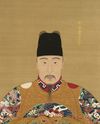
|
1521–1567 | Zhū Hòucōng 朱厚熜 |
Jiājìng 嘉靖 |
Sùdì 肅帝 |
Shìzōng 世宗 |
| Longqing Emperor Great Celebration |
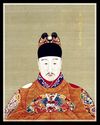
|
1567–1572 | Zhū Zǎijì 朱載坖 |
Lóngqìng 隆慶 |
Zhuāngdì 莊帝 |
Mùzōng 穆宗 |
| وانلي الامبراطور عشرة آلاف تقويم |
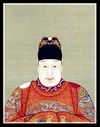
|
1572–1620 | Zhū Yìjūn 朱翊鈞 |
Wànlì 萬曆 |
Xiǎndì 顯帝 |
Shénzōng 神宗 |
| تايتشانگ الامبراطور الازدهار العظيم |
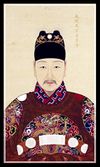
|
1620 | Zhū Chángluò 朱常洛 |
Tàichāng 泰昌 |
Zhēndì 貞帝 |
Guāngzōng 光宗 |
| Tianqi Emperor الانفتاح السماوي |
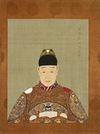
|
1620–1627 | Zhū Yóujiào 朱由校 |
Tiānqǐ 天啟 |
Zhédì 悊帝 |
Xīzōng 熹宗 |
| چونگژن الامبراطور Honorable and Auspicious |
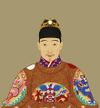
|
1627–1644 | Zhū Yóujiǎn 朱由檢 |
Chóngzhēn 崇禎 |
Lièdi 烈帝 |
Sīzōng 思宗 |
| 1 As posthumous and temple names were often shared by emperors of different dynasties, they are usually preceded by the dynastic name, in this case, Ming, to avoid confusion. For example, the Hongwu Emperor is frequently referred to as Ming Taizu. | ||||||
| 2 The Yongle Emperor assumed the throne of his nephew, the Jianwen Emperor, who died in a palace fire. The Yongle Emperor wiped out the record of his nephew's reign and no temple name was given him. | ||||||
| 3 After listening to poor advice from his eunuch advisers, Emperor Yingzong of Ming personally led a campaign in 1449 against the Mongols and was captured. His younger brother, the Jingtai Emperor, assumed the throne in 1449, and a hostage no longer of any value, the Mongols released the Emperor Yingzong of Ming who returned to live in seclusion. However, Emperor Yingzong of Ming was able to reclaim his position upon the illness of Jingtai Emperor in 1457. | ||||||
أباطرة أسرة مينگ الجنوبية
| Personal name | Temple name | Era name | Years of Reigning | Name by which most commonly known |
|---|---|---|---|---|
| Zhū Yóusōng 朱由崧 |
Ānzōng 安宗 |
Hóngguāng 弘光 |
1644–1645 | Prince of Fu 福王 Fú Wáng |
| Zhū Yùjiàn 朱聿鍵 |
Shàozōng 紹宗 |
Lóngwǔ 隆武 |
1645–1646 | Prince of Tang 唐王 Táng Wáng |
| Zhū Chángfāng 朱常淓 |
none | None given, but sometimes referred to as the Regency of the Prince of Lu (Luh) 潞王臨國 Lù Wáng Lín Guó |
1645–1646 | Prince of Lu (Luh*) 潞王 Lù Wáng |
| Zhū Yǐhǎi 朱以海 |
none | Gēngyín 庚寅 |
1645–1655 | Prince of Lu (Lou*) 魯王 Lǔ Wáng |
| Zhū Yùyuè 朱聿鐭 |
none | Shàowǔ 紹武 |
1646–1647 | Prince of Tang 唐王 Táng Wáng |
| Zhū Chángqīng 朱常清 |
none | Dōngwǔ 東武 |
1648–1649 | Prince of Huai 淮王 Huái Wáng |
| Zhū Yóuláng 朱由榔 |
Zhāozōng 昭宗 |
Yǒnglì 永曆 |
1646–1662 | Prince of Gui 桂王 Guì Wáng |
- The two characters are homonyms, both pronounced Lu; to distinguish them, one is usually kept as Lu and the other spelled differently. Luh is from Cambridge History of China; Lou is from A.C. Moule's Rulers of China (1957). When one irregular spelling is used, the other is kept as regular (Lu). The two systems are distinct and not used simultaneously.
- After the death of these princes, there is no temple name. The temple name appearing on the Internet has no source.[1]
- Other Ming claimants included Prince Dingwu of Han (Zhu Benli, 1646–1663) and Prince of Huai (Zhu Changqing, 1648–1661).
- If Zhu Benli existed, he would be the last legal emperor of Southern Ming from the execution (1662) of Zhu Youlang. However, Zhu Benli's identity and existence is of some dispute, and Zhu Youlang is generally taken to be the last emperor of Southern Ming.[2]
- Ming Prince Zhu Shugui carried out his duties in the Kingdom of Tungning in the name of the last Southern Ming Emperor until 1683.
انظر أيضاً
- List of vassals prince peerages of Ming dynasty
- Dynasties in Chinese history
- List of Chinese monarchs
- Southern Ming topics
المراجع
- ^ Lynn A., Struve (1984). The Southern Ming, 1644-1662. Yale University Press. ISBN 9780300030570.
- ^ Michael Dillon (ed.). Encyclopedia of Chinese History. Routledge. p. 645. ISBN 9781317817161.
This article contains content from Wikimedia licensed under CC BY-SA 4.0. Please comply with the license terms.